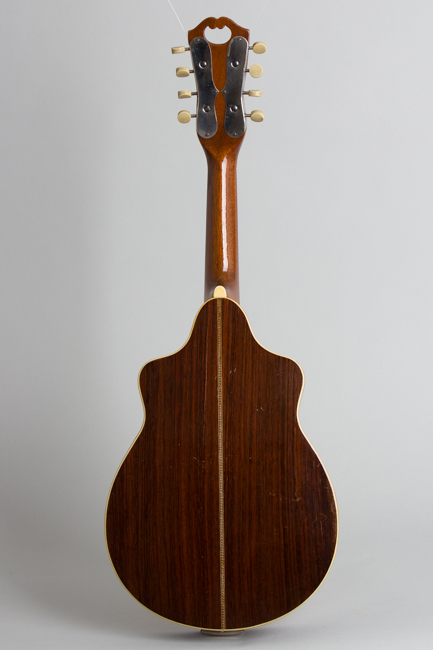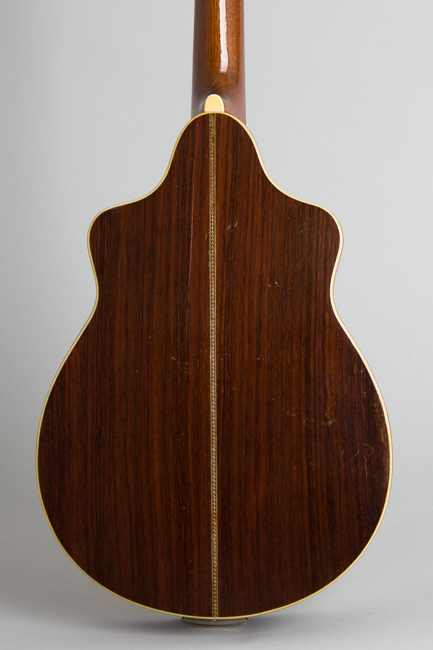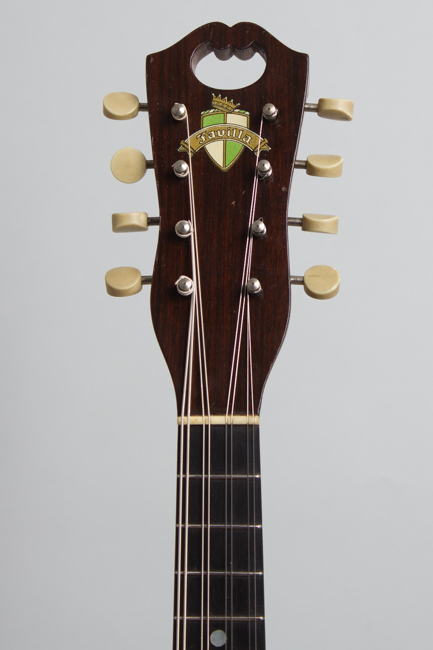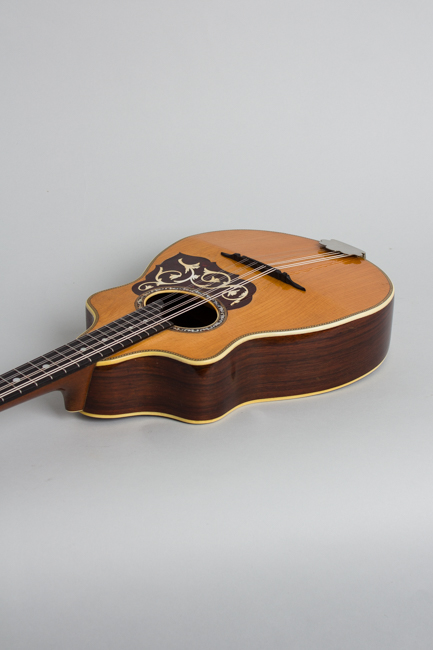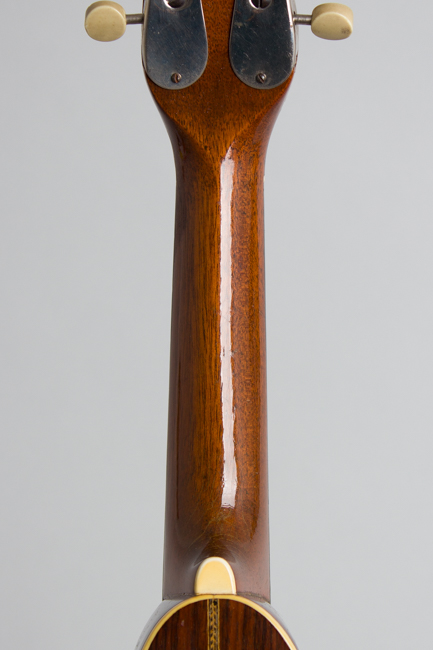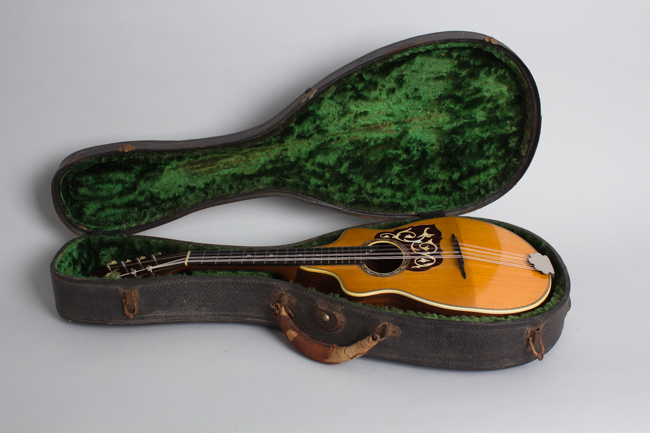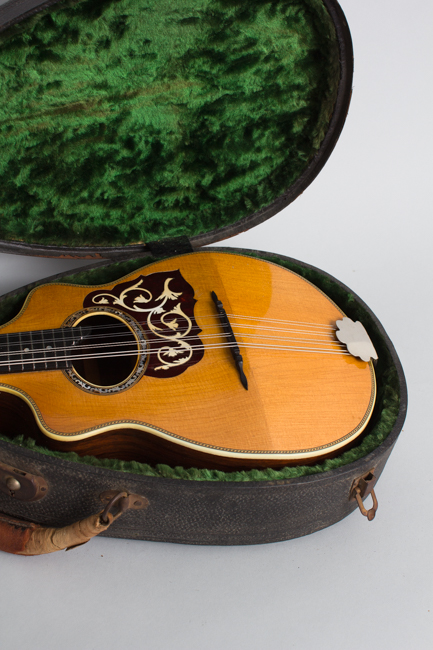Favilla Flat Back, Bent Top Mandolin (1920s)
Favilla Flat Back, Bent Top Mandolin (1920s), made in New York City, natural finish, mahogany back and sides, spruce top; mahogany neck with ebony fingerboard, original black hard shell case.
This is a fascinating and beautiful mandolin, not only a fine sounding and playing piece but amazingly well preserved for an instrument from this time and place. New York City in the 1910's and 1920's was teeming with immigrants, including large numbers from Italy. The first quarter of the 20th Century saw the establishment of what has become referred to recently as "The Italian Guild"- not really an organization but multiple semi-affiliated small retail stores and instrument building workshops operated by Italian immigrant luthier/businessmen including Raphael Ciani, Antonio Cerrito, J. Nettuno, Nicola Turturro and others.
The Favilla Brothers founded one of the most enduring of these firms which through many twists, turns and family changes lasted into the 1970's. While sometimes similar in design, instruments produced in these small Little Italy shops exhibit a wide range of design, detail and levels of craftsmanship. Bowl back mandolins predictably were initially the most popular offering, but in the 1920's several makers moved away from that "old country" paradigm offered new mandolin designs that showed a lot of original character.
This Favilla Bros. mandolin dates to around that time. After the First World War as the traditional Neapolitan bowl-back mandolin was falling out of favor. Gibson's carved-top instruments were the main competition; they had largely replaced the bowl-back in the popular imagination by 1920. New York luthiers took some time to adapt to the carved-top concept, however. This bent-top, flat back body design with body points near the neck joint was one novel idea, and we have seen examples of similar instruments made in the Ciani shop, whose foreman at the time was John D'Angelico. This Favilla shares trim and inlay patterns with these, and there was likely influence going both ways at the time.
On its own merits this is a simply lovely instrument, as finely made as any similar mandolin we have seen. 1950's and '60's Favilla brand guitars and ukes were solid but basic in design; this 1920's example is a lovely creation of first-rate materials, finely crafted. The 2-point body is made from beautifully grained Brazilian rosewood with a superbly tight-grained spruce top. The top and back are ivoroid bound with half herringbone marquetry trim on the face. The inlaid pickguard has floral celluloid inlay and the soundhole is bound and bordered with pearl-in-mastic decoration.
The mahogany neck has a dot inlaid ebony fingerboard and is topped by a Vinaccia-style cut-through peghead. The rosewood headstock face is adorned with a colorful Favilla crest decal. This is one of only a couple of this type of mandolin we have ever seen, and as nice an example as we can imagine.
Overall length is 25 1/8 in. (63.8 cm.), 9 7/16 in. (24 cm.) wide at lower bout, and 2 3/8 in. (6 cm.) in depth at side, taken at the end block. Scale length is 14 in. (356 mm.). Width of nut is 1 3/16 in. (30 mm.).
This century-or-so mandolin remains amazingly clean overall with very little play wear, especially for its age. There is moderately heavy checking to the finish overall with small dings and dents but not many signs of it actually being played. The only major repair is a sealed grain split to the back to the back below the backstrip. This mandolin plays and sounds excellent with a very attractive sweet tone. It resides in what appears to be the original hard shell case. Excellent - Condition.
This is a fascinating and beautiful mandolin, not only a fine sounding and playing piece but amazingly well preserved for an instrument from this time and place. New York City in the 1910's and 1920's was teeming with immigrants, including large numbers from Italy. The first quarter of the 20th Century saw the establishment of what has become referred to recently as "The Italian Guild"- not really an organization but multiple semi-affiliated small retail stores and instrument building workshops operated by Italian immigrant luthier/businessmen including Raphael Ciani, Antonio Cerrito, J. Nettuno, Nicola Turturro and others.
The Favilla Brothers founded one of the most enduring of these firms which through many twists, turns and family changes lasted into the 1970's. While sometimes similar in design, instruments produced in these small Little Italy shops exhibit a wide range of design, detail and levels of craftsmanship. Bowl back mandolins predictably were initially the most popular offering, but in the 1920's several makers moved away from that "old country" paradigm offered new mandolin designs that showed a lot of original character.
This Favilla Bros. mandolin dates to around that time. After the First World War as the traditional Neapolitan bowl-back mandolin was falling out of favor. Gibson's carved-top instruments were the main competition; they had largely replaced the bowl-back in the popular imagination by 1920. New York luthiers took some time to adapt to the carved-top concept, however. This bent-top, flat back body design with body points near the neck joint was one novel idea, and we have seen examples of similar instruments made in the Ciani shop, whose foreman at the time was John D'Angelico. This Favilla shares trim and inlay patterns with these, and there was likely influence going both ways at the time.
On its own merits this is a simply lovely instrument, as finely made as any similar mandolin we have seen. 1950's and '60's Favilla brand guitars and ukes were solid but basic in design; this 1920's example is a lovely creation of first-rate materials, finely crafted. The 2-point body is made from beautifully grained Brazilian rosewood with a superbly tight-grained spruce top. The top and back are ivoroid bound with half herringbone marquetry trim on the face. The inlaid pickguard has floral celluloid inlay and the soundhole is bound and bordered with pearl-in-mastic decoration.
The mahogany neck has a dot inlaid ebony fingerboard and is topped by a Vinaccia-style cut-through peghead. The rosewood headstock face is adorned with a colorful Favilla crest decal. This is one of only a couple of this type of mandolin we have ever seen, and as nice an example as we can imagine.
Overall length is 25 1/8 in. (63.8 cm.), 9 7/16 in. (24 cm.) wide at lower bout, and 2 3/8 in. (6 cm.) in depth at side, taken at the end block. Scale length is 14 in. (356 mm.). Width of nut is 1 3/16 in. (30 mm.).
This century-or-so mandolin remains amazingly clean overall with very little play wear, especially for its age. There is moderately heavy checking to the finish overall with small dings and dents but not many signs of it actually being played. The only major repair is a sealed grain split to the back to the back below the backstrip. This mandolin plays and sounds excellent with a very attractive sweet tone. It resides in what appears to be the original hard shell case. Excellent - Condition.


